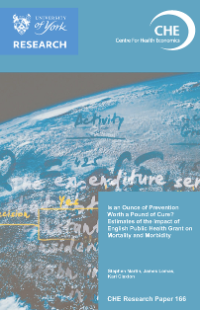Is an ounce of prevention worth a pound of cure? Estimates of the impact of English public health grant on mortality and morbidity
CHE's latest Research Paper 166 written by Stephen Martin, James Lomas, Karl Claxton

Most previous attempts to estimate the marginal productivity of English health care expenditure have employed instruments that rely on statistical tests alone for their justification. A new approach to instrumentation has proposed the use of ‘funding rule’ variables as instruments, which can be justified on theoretical grounds. We exploit the availability of a funding formula for local authority (LA) public health expenditure in England to investigate the relationship between such expenditure and mortality. Although there have been many studies of the impact of specific health promotion activities on outcomes, we are not aware of any successful attempts to relate English public health expenditure to mortality. Moreover, by converting healthcare (treatment) expenditure to a local authority geography, we are also able to estimate an outcome specification that includes both treatment (healthcare) and prevention (public health) expenditure. This enables us to identify the relative contribution of both types of expenditure to reductions in mortality. Previously published work has linked effects on disease specific mortality to changes in quality-adjusted life years. We use these estimates to report the cost per quality-adjusted life year (QALY) for both treatment and public health (prevention) expenditure.
Full Report: CHE Research Paper 166 (PDF ![]() , 2,275kb)
, 2,275kb)
Other papers in the CHE Research paper series can be found at: CHE Research Papers